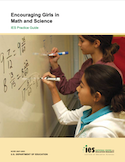Girls in Math & Science
Explore resources designed to support girls' success in math and science. 
- View a visual diagram of all five practices
- Watch a topic overview and download planning templates
- Listen to an expert
Explore the subtopics below to learn more about the recommended practices:
- Ability is Expandable
- Prescriptive Feedback
- Female Role Models
- Sparking Curiosity
- Teaching Spatial Skills
To learn more about the research underlying these practices, view the IES Practice Guide, Encouraging Girls in Math and Science.
- Items 1 - 12 of 69
Sort by:
Encouraging Girls in Math and Science
Girls in Math & Science > Overview & Tools
Women are less involved in career paths and post-secondary education in some areas of math and science than men. This pattern starts at school. Use this short overview to learn about the strategies...
Resource Type
Overview
Teaching Spatial Skills to Girls
Girls in Math & Science > Teaching Spatial Skills > Overview & Tools
This overview describes some of the gender differences in test performance; ways in which spatial skills are used in school, careers, and normal life; and approaches to teaching spatial skills.
Resource Type
Overview
Ability Is Expandable
Girls in Math & Science > Ability is Expandable > Overview & Tools
Learn about the importance of helping students realize that improving and expanding their academic abilities leads to success in math, science, as well as other subjects. This overview presents a...
Resource Type
Overview
Prescriptive Feedback
Girls in Math & Science > Prescriptive Feedback > Overview & Tools
This multimedia overview defines "prescriptive, informational feedback" and provides guidelines to teachers in how they can provide that type of feedback and the effect it can have on their students.
Resource Type
Overview
Sparking Girls' Interest in Math and Science
Girls in Math & Science > Sparking Curiosity > Overview & Tools
Learn what situational interest is and how it might transform into a long-term interest. View strategies designed to capture girls' interest in math and science courses.
Resource Type
Overview
Female Role Models in Math and Science
Girls in Math & Science > Female Role Models > Overview & Tools
Learn about ways to teach that gender stereotypes are not true. This overview demonstrates the different ways to expose students to role models.
Resource Type
Overview
Encouraging Girls in Math and Science (Part 1)
Girls in Math & Science > Overview & Tools
This interview features Dr. Diane Halpern, chair of the expert panel that produced the Practice Guide. In Part 1 of the interview, Dr. Halpern describes the research evidence and reasoning for the...
Resource Type
Expert Interview
Encouraging Girls in Math and Science (Part 2)
Girls in Math & Science > Overview & Tools
This interview features Dr. Diane Halpern, chair of the expert panel that produced the Practice Guide. In Part 2 of the interview, Dr. Halpern discusses implementation ideas and roles that school...
Resource Type
Expert Interview
The Importance of Female Role Models
Girls in Math & Science > Female Role Models > See How It Works
A teacher and member of the Encouraging Girls in Math and Science expert panel shares experiences in teaching about female role models in math and science. She describes the role of teachers and...
Resource Type
Expert Interview
Stereotype Threat (Part 1)
Girls in Math & Science > Female Role Models > Learn What Works
Listen to Dr. Joshua Aronson describe what stereotype threat is and how it can impact academic achievement. Related Files: Stereotype Threat (Part 2) (Audio)
Resource Type
Expert Interview
Instructional Methods That Spark Curiosity (Part 1)
Girls in Math & Science > Sparking Curiosity > Learn What Works
Dr. Jon Star discusses interest as a development process. Instructional activities that may spark children's curiosity can be the basis for a sustained individual interest later in...
Resource Type
Expert Interview
Stereotype Threat (Part 2)
Girls in Math & Science > Female Role Models > Learn What Works
In this interview, Dr. Joshua Aronson describes how to reduce stereotype threat by introducing students to role models and emphasizing gender similarities, rather than gender differences. Related...
Resource Type
Expert Interview

















